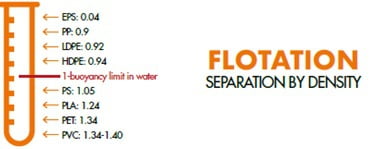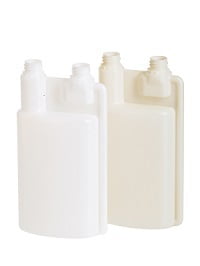GET THE GRIP ON GREEN #6 – PE/PP RECYCLING PROCESS
The first two steps are the same for each plastic recycling:
- Collection: Plastics usually all end up in the same bin or bag in our household waste.
- Sorting: By size, rigid packaging & flexibles, by polymer type and by colour. Metals and other materials will be sorted out here. Afterwards, the processing of the polymers follows.
What kind of rigid PP and PE, which means HDPE and LDPE, packaging will be recycled, depends on the country. Usually, at least bottles and flasks out of HDPE will be recycled, e.g. in Belgium, Italy, Ireland. Countries like UK, Germany, the Netherlands, Spain, and parts of France (as of 2022 everywhere), are recycling all kind of PE packaging.
The difference between HDPE and LDPE is the density:
HD = high density
LD = low density
They can be separated during the recycling process, but they are not causing any issues, if they end up in the same recycling stream, because the basic chemical structure is the same.
The French waste manager published this picture, which shows the different positions of plastics, if they are mixed with. These different positions of the plastics have to do with their densities (in g/cm3). This method, called “Flotation”, is used in the recycling process to separate the different plastics. Details about this step will follow.
But how are PE and PP usually processed during the recycling process?
PE and PP have different recycling streams, and will be recycled separately. But the process steps are exactly the same, as follows:
– Shredding: the material into small pieces
– Washing: a bath with circulating water (ca. 40°C) removes most residuals, labels and adhesives
– Separation by density (Flotation): Different plastics are separated by different density, so one is sinking and the other is floating. PE and PP have a density < 1 g/cm3, so it’s floating in water. The floating plastic will be separated. Density ranges may overlap (PE & PP), that makes it challenging to guarantee a material purity.
– Colour sorting: Depending on the recycler, a colour sorting process happens.
– Pellets: Flakes are further processed (melted) into pellets – that’s the final recyclate.
Why is the label & adhesive in combination with the container important for recycling?
The a. material (& density), b. adhesive and c. print & size of the label are relevant for recyclability of the packaging.
a. The material (& density): is important, because of the detectability and the density. As you already know, a label made from PVC prevents the detection of the container material, because the NIR can’t detect through the PVC. The result is, that the whole packaging can’t be sorted right and won’t be recycled.
For PE-containers we can use a PE or PET-label. If a PE-label on a PE container is used, the detectability is not a problem, because the NIR detects PE anyway. If a PET-label is used, the following points (b. & c.) should be respected to ensure that the container is detectable. The advantage is, that PET and PE can be separated through its density during the Flotation process. Because of the Flotation-method, it is better to avoid PP labels, to keep the PE material as pure as possible. Because density ranges of PE & PP are very similar, it makes it challenging to separate them.
b. The adhesive : is important, because if the adhesive of the label is not water soluble, it can’t be removed from the packaging and may contaminate the batch. This would cause a poorer quality of the processed material or the entire batch can’t be processed anymore.
Because the water temperature of the washing process has only about 40°C, there are not a lot of suitable adhesives, which can be used. If we would use a water soluble glue, the label of the packaging wouldn’t be very stable in an environment with high moistures, e.g. kitchens or bathrooms. If we need a higher stability of the adhesive, it would mean, that the adhesive might disturb the recycling process, because it’s not water soluble.
Currently, the label producers are looking for a suitable solution for this issue.
c. the print and size of the label can influence the detectability. If a label is used, which is made from another material than the container, the thickness of the label material can influence the detectability. If the label material is too thick or the print doesn’t allow the NIR-light to pass the label, the container material can’t be detected. This causes a wrong sorting and avoids recycling or disturbs other streams because of contaminations. Metallised labels are usually not acceptable, because they reflect the NIR-light, which avoids a detection of the container material.
So, it would be the right way to let the detectability check by a recycling institute to prove it.
How is the quality of the rHDPE and rPP?
– Colour: rHDPE has a green or grey look, because some different colours are mixed together. That is different to the PET recycling. rPP is more greyish than the virgin one, because colours can be mixed. Both recycled materials can be coloured again.
– Processing: Sometimes it is necessary to adapt production processes for recycled materials, because it is already strained. The mechanical recycling process downgrades the material slightly. That’s why plastics are not endless recyclable, but at least a few times. The recyclate won’t be used anymore, when it gets a poor quality, that means changed material properties, contaminations, etc.
– Source & Food grade: rHDPE/ rPP are made from post-consumer waste (PCR). This is why the recyclate isn’t as pure as virgin material. It contains ingredients which can’t be washed off during the usual mechanical recycling process and are the reason why the materials don’t have food-grade. Other technologies in the future might be able to produce purified PCR material.
Why the recycling of PE and PP seems more easy than for PET?
Recycled PE and PP has instead of rPET a bigger market. For PET, only the clear recyclate are interesting for the market. PE and PP can be used for a lot of application in the non-food sector, e.g. tubes, outdoor furniture, plant tubs, etc. For these applications, the colour whether is dark, e.g. grey, black, brown, or not that relevant for the use. That makes it easier to reuse the material.
During the recycling process, it happens regularly, that PE and PP will be mixed. This happens because the densities are very similar and a lot of effort would be needed to separate the two materials completely. That means, rHDPE or rLDPE has usually a share of rPP in it as well. This is accepted by the recyclers and producers, because the machines can be adapted to the small differences in processing.
Due to the rapid evolution of the sustainability into the packaging sector as well as local differences of recycling processes and law, information provided within this document are for information only.
We advise you to check your local regulation’s update.



